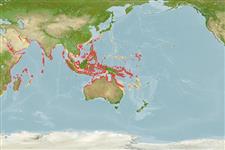>
Eupercaria/misc (Various families in series Eupercaria) >
Labridae (Wrasses) > Corinae
Etymology: Halichoeres: Greek, als, alis = salt + Greek, choiros = pig (Ref. 45335).
More on author: Bennett.
Environment: milieu / climate zone / depth range / distribution range
экология
морской ассоциированный с рифами; пределы глубины 1 - 20 m (Ref. 90102). Tropical; 32°N - 24°S
Indo-West Pacific: Red Sea and East Africa (Ref. 2334) to Papua New Guinea, north to Japan, south to the Great Barrier Reef in Australia.
Size / Вес / Возраст
Maturity: Lm ? range ? - ? cm
Max length : 20.0 cm TL самец/пол неопределен; (Ref. 30573)
Краткое описание
определительные ключи | морфология | морфометрия
колючие лучи спинного плавника (общее число) : 9; членистые (мягкие) лучи спинного плавника (общее число) : 11; колючие лучи анального плавника: 3; членистые (мягкие) лучи анального плавника: 11. The initial phase is olivaceous to brownish yellow dorsally, white ventrally, with a black zigzag stripe running from eye to upper caudal peduncle (continuing anteriorly as a yellow stripe from the eye to the snout). This primary phase is similar to H. trimaculatus except for the black zigzag stripe along its back (Ref. 1602). The terminal phase is green, the zigzag stripe lavender-pink with its anterior portion overlaid by a black blotch.
Common in shallow lagoons or bays; usually over sand, rubble, or seagrass bottom (Ref. 41878), rather than on coral reefs. May be found in groups (Ref. 90102). Usually solitary and aggressive towards members of its own species. Feeds on small crustaceans by picking them off the sandy bottom (Ref. 5503).
Life cycle and mating behavior
половая зрелость | размножение | нерест | икра | Fecundity | личинки
Distinct pairing during breeding (Ref. 205). Pelagic spawner (Ref. 32193).
Randall, J.E., G.R. Allen and R.C. Steene, 1990. Fishes of the Great Barrier Reef and Coral Sea. University of Hawaii Press, Honolulu, Hawaii. 506 p. (Ref. 2334)
Статус Красного Списка МСОП (Ref. 130435: Version 2024-1)
Угроза для людей
Harmless
Использование человеком
рыболовство: не имеет хозяйственного значения; аквариум: коммерческий
дополнительная информация
инструменты
Специальные отчеты
Скачать в формате XML
ресурсы в Интернет
Estimates based on models
Preferred temperature (Ref.
123201): 26.2 - 29.3, mean 28.6 °C (based on 2756 cells).
Phylogenetic diversity index (Ref.
82804): PD
50 = 0.5000 [Uniqueness, from 0.5 = low to 2.0 = high].
Bayesian length-weight: a=0.01000 (0.00574 - 0.01742), b=3.14 (2.99 - 3.29), in cm total length, based on LWR estimates for this species & Genus-body shape (Ref.
93245).
Trophic level (Ref.
69278): 3.5 ±0.50 se; based on food items.
Generation time: 1.8 ( na - na) years. Estimated as median ln(3)/K based on 1
growth studies.
устойчивость к внешним воздействиям (Ref.
120179): высокий, минимальное время удвоения популяции до 15 месяцев (K=0.6).
Fishing Vulnerability (Ref.
59153): Low vulnerability (23 of 100).
Nutrients (Ref.
124155): Calcium = 81.2 [48.7, 136.7] mg/100g; Iron = 0.733 [0.426, 1.332] mg/100g; Protein = 18.6 [15.7, 20.8] %; Omega3 = 0.147 [0.096, 0.229] g/100g; Selenium = 24 [15, 43] μg/100g; VitaminA = 108 [35, 388] μg/100g; Zinc = 1.57 [1.09, 2.43] mg/100g (wet weight);
